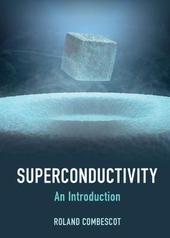
|
Superconductivity: An Introduction
Hardback
Main Details
| Title |
Superconductivity: An Introduction
|
| Authors and Contributors |
By (author) Roland Combescot
|
| Physical Properties |
| Format:Hardback | | Pages:400 | | Dimensions(mm): Height 262,Width 184 |
|
| Category/Genre | Materials science |
|---|
| ISBN/Barcode |
9781108428415
|
| Classifications | Dewey:537.623 |
|---|
| Audience | | Tertiary Education (US: College) | |
|---|
| Illustrations |
Worked examples or Exercises; Worked examples or Exercises
|
|
Publishing Details |
| Publisher |
Cambridge University Press
|
| Imprint |
Cambridge University Press
|
| Publication Date |
17 March 2022 |
| Publication Country |
United Kingdom
|
Description
Superconductivity is among the most exciting of quantum phenomena in condensed matter physics, and has important applications across science and technology, from fusion reactors to particle accelerators. This self-contained text provides a comprehensive account of the physical foundations of superconductivity and related recent developments in the field. Beginning with a detailed description of the BSC theory of superconductivity, the book then describes the subsequent successes of this landmark theory and proceeds to more advanced topics such as Josephson effects and vortices. The strong coupling theory of superconductivity is introduced in later chapters, providing a springboard to important current research on hydride superconductors, which have displayed very high critical temperatures. Recent manifestations of superfluidity in ultracold atoms physics are also described. This book will give readers a solid grounding in the theory and applications of superconductivity, and an appreciation of its broader importance in the field of modern condensed matter physics.
Author Biography
Roland Combescot is Professor Emeritus in Physics at Ecole Normale Superieure (ENS) and Sorbonne Universite (formerly Universite Pierre et Marie Curie) in Paris, and has been a member of l'Institut Universitaire de France (IUF) since 2005. He has an outstanding research and publication record in the area of superconductivity and superfluidity, including nearly thirty articles published in the influential journal, Physical Review Letters. He has taught a course on the theory of superconductivity to MSc students at ENS for over twenty years.
Reviews'A solid, down-to-earth book which presents the essentials of the BCS theory of superconductivity without relying on advanced formal techniques; it is particularly good at getting across difficult points in informal terms, and in making contact with experiments where needed. Distinguishing features include substantial discussions of the ultracold atomic gases, and of the Eliashberg-based theory of strong coupling superconductivity in a form where it may be applicable to the nearly-room-temperature metallic hydrides. It should be a useful basis for courses for advanced undergraduates or graduate students not specialized in the topic.' Prof. Anthony J. Leggett, University of Illinois Urbana-Champaign 'This is an excellent introductory textbook on superconductivity. It starts with a description of the basic phenomena, follows the sequence of historical discoveries and describes the various models proposed to explain them and to predict new effects. From chapter to chapter, Roland Combescot exposes in simple and elegant terms the quantum subtleties of superconductivity, develops step-by-step the various theoretical approaches and illustrates them with deep physical interpretations of the equations. The connection between condensed matter and cold atom physics is particularly interesting, with an illuminating description of the cross-over between the BEC and the BCS regimes of degenerate fermionic gases. This development, which shows that similar phenomena occur in very disparate systems, illustrates the deep unity of physics. This textbook will interest readers familiar with basic quantum physics and curious to understand the theory of superconductivity, as well as those interested in its various technological applications. It is a simple and particularly clear introduction for undergraduate and graduate students. I believe that it will also serve as a useful guide for teachers of a field of physics which - having been active for more than a century - still raises unanswered questions and promises new surprises.' Prof. Serge Haroche, Ecole Normale Superieure and College de France
|